

April 1999 Published in Sighthound Review, August/September/October issue 1999 |
|||
The first part of the journey took us from Tunis across Tunisia to the west heading for the town of Ghardimaou, close to the Algerian border and at the foot of the Atlas Mountains. It is a wonderful drive at this time of the year, with lush green landscape, fields crimson with poppies, and storks nesting on high trees. Three hours later and the afternoon drawing to its end, we drove the narrow red dirt road winding up the hill through an endless plantation of olive trees, and arrived at the Ferme Baraket, first stop of our itinerary. We entered the main courtyard, surrounded by the stalls of Arabian horses. The pack of Sloughis got up from their sprawl in the sun and came to greet us, barking and tails wagging. |
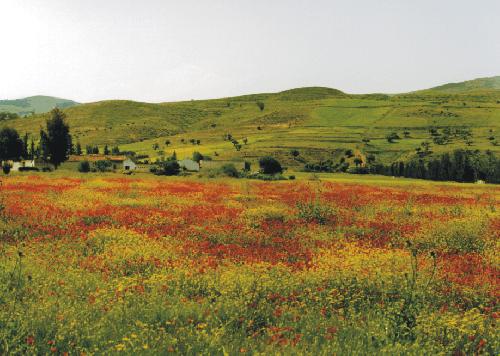
Poppies in bloom ©Anne d'Ersu |
||
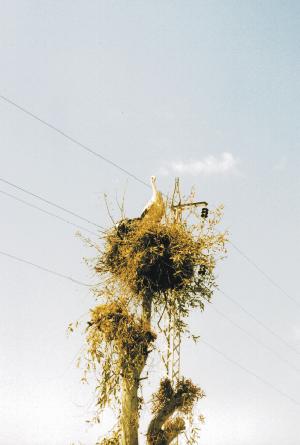
Storks nesting ©Anne d'Ersu |
|||
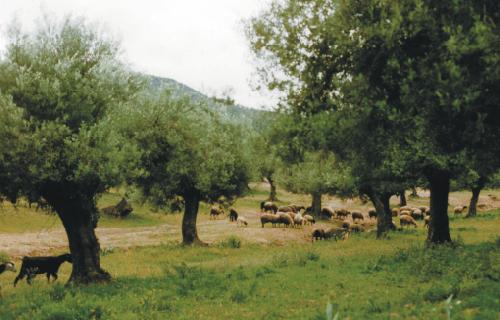 |
|||
I had wanted to see this place for many years. Old friends, Brigitte and Herbert Biebach, whom I had met at the Max Planck Institute in Seewiesen, near Munich, where we were working on our PhDs, had told me about it as early as 1973 when they showed me their pictures of Tunisian Sloughis. Ever since, pictures of Sloughis from their various excursions down there were generously forwarded to me. Two months ago recent pictures arrived including one of a wonderful red brindle bitch, which said at the back; "Ramla, about a year old, still available". |
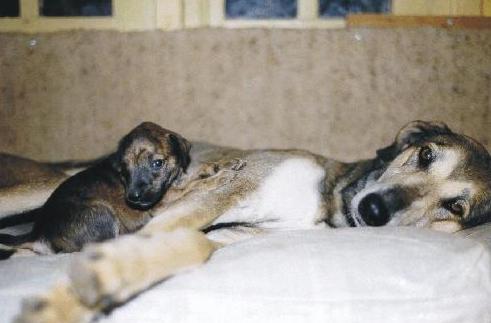
Mountain Sloughia, Ghardimaou ©Dominique de Caprona |
||
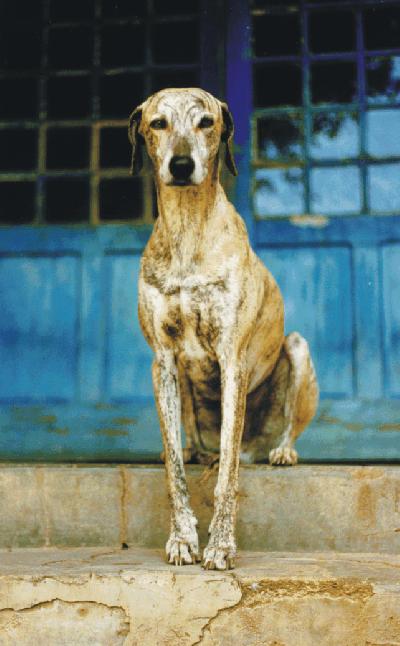
Mountain Sloughi,Ghardimaou ©D. de Caprona |
|||
Arabian horses, Meknassy ©Dominique de Caprona  |
|||
The following days, we started to look for other Sloughis in the area, to find that most of their owners were working or out hunting, so we decided to come back later and in the meantime go south. We drove with Gisela and Jürgen to Meknassy to visit with two Berber families who had a few Sloughis, stopping to look at the Roman ruins of Sbeitla on our way. In Meknassy, we first drove on a dirt road to Hussein Ghabri's home out of town. Hussein and his family are of an old aristocratic Berber family of the Zenata people, and Hussein himself a great fancier of the Sloughi. We arrived at the end of the afternoon, and saw one red Sloughi which had been hit by a car while hunting, and although he had recovered quite well could not run intensively anymore. There was also a sand bitch and a puppy. We were told that since the dog had been injured, the jackals were coming back around the settlement and attacking their livestock; this is why they had acquired the puppy. We also went to see the horses at a breeding facility outside of town. |

Sloughi pup playing with harness, Meknassy © D. de Caprona |
||
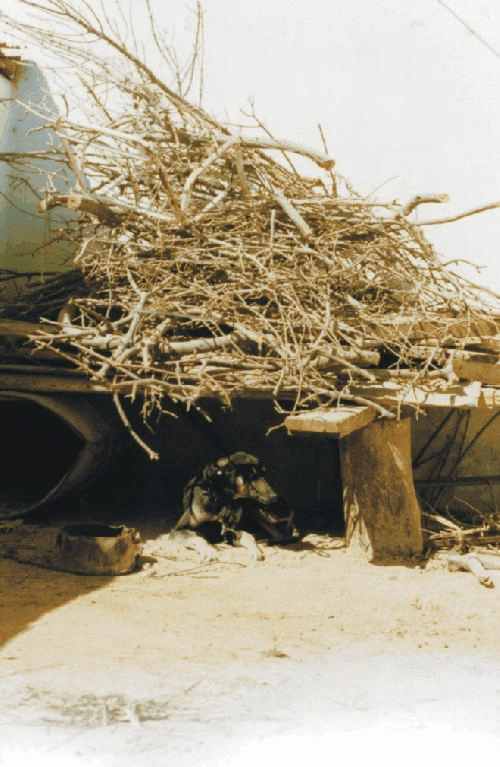
Black mantel Sloughia, Meknassy © Anne d'Ersu |
|||
Kabyl dog, Meknassy
© Dominique de Caprona
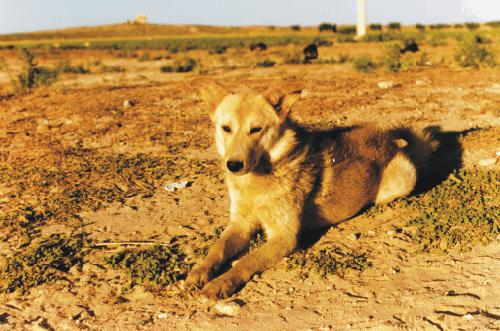 |
|||
Back to Meknassy itself, we visited their cousins , the family of the Caid Mohamed Jelaila, who ruled the South from 1955-1971. His son had two Sloughias, one black mantel, the other sand brindle and very ill. We were treated to a great couscous and received an offer to spend the night. We left very early in the morning and the next ride took us far south to Douz, entrance to the Sahara Desert. This town is built on the sand, and we started looking for Salem Gharzallah's house. Salem Gharzallah is a Fantasia rider and a member of the Merazik people, who breeds Sloughis. After a couple of missed turns, we arrived at a small square with a few trees and a group of goats under their shade. A Sloughia came out of the house followed quickly by two seven-week-old puppies. After greeting Salem Gharzallah and his family , we stood there for a while observing the antics of these puppies in the sand. None of Salem's Sloughis had cropped ears; the bitch was brand-marked with a circle on her left thigh. |
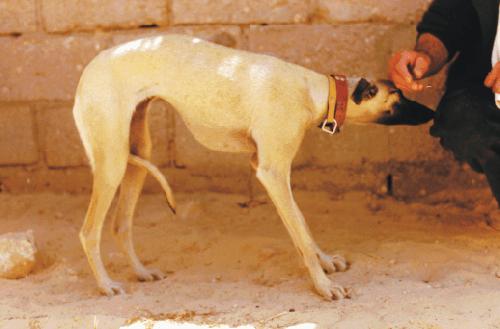
Desert Sloughia, Douz © D. de Caprona |
||

Rym with mom and sister, Douz ©D. de Caprona |
|||
7 months old
desert Sloughi, Douz © D. de Caprona
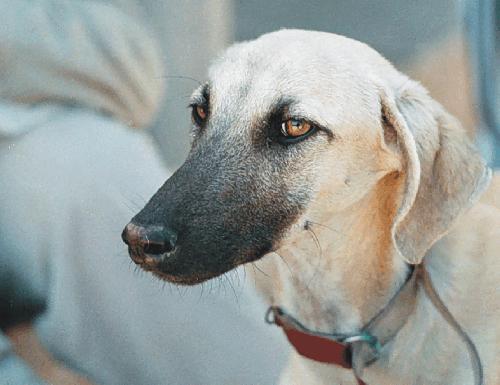 |
|||
Salem passed around pictures of the red brindle Sloughi dog, sire of the litter, who was not there at the time, lent to a friend for hunting. He also took us to various friends in Douz who also had Sloughis. All the dogs we saw were "sand/black mask", and the bitches on the smallish side, but all had the features of a Sloughi as we know it; some with cropped ears, and more lightly built than the mountain type Sloughis around Ghardimaou. After visiting the town a bit, we came back to Salem's house where we were again spoiled with a wonderful meal, sitting on the rugs around the flat table. As we ate and talked about the Sloughi, I asked Salem what he planed to do with the puppies. He said he would keep the brindle but that the red sand bitch was still available. We talked about the origin of his Sloughia; he said she was bred by the Rebayat people, nomads of the Sahara Desert. I studied that little bitch for a while. In the end, little Rym Cassandra sat on my lap all the way home. |
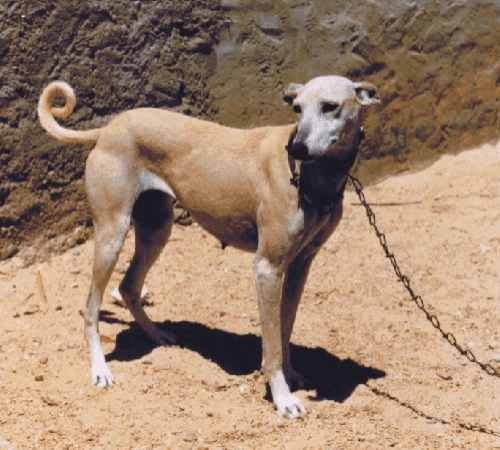
Desert Sloughia with cropped ears, Douz © D. de Caprona |
||
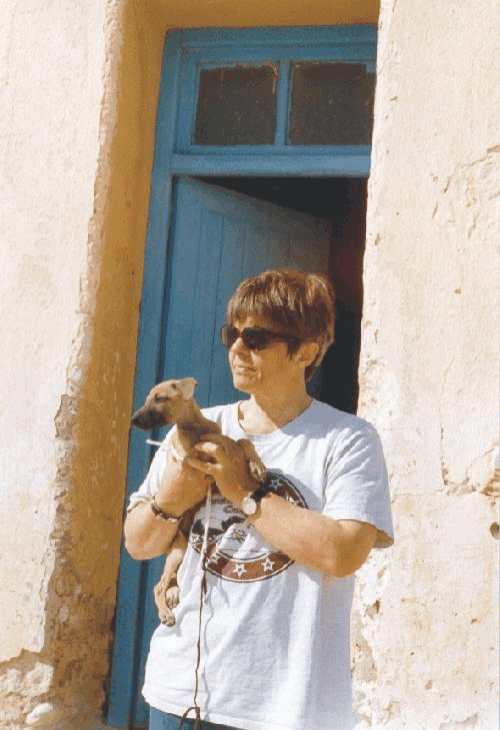
Rym and Dominique © Anne d'Ersu |
|||
Sahara Desert,
Douz © D. de Caprona
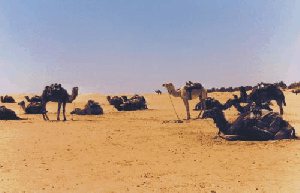 |
|||
We stopped on our way back at Hussein Ghabri's place and we put the little puppy in his hands. A bright smile crossed his face as he handled it, and although he has long ago lost his sight, he knew right away, just by going over it with his hands, that this was a typical puppy of the breed he had fancied for so many years. His son, Ridha, who breeds Arabian horses, was there this time and entertained us all evening, first around dinner, then in his own house with stories of horses and hunting with Sloughis on horseback. We were again offered to stay overnight, and on our way back next morning, we stopped in Meknassy to pick up the very ill bitch and took her back with us to Ghardimaou, in the hope that the veterinarians in Tunis would find a cure. Back in Ghardimaou, we went the next day to visit the people we had missed before in Bou Salem. All were there to meet us and it was with great anticipation that we went to see their Sloughis with the assistant of the local veterinarian, Nouredine Arfaoui. We saw the Sloughis of Raouf Ochi and Jamel Rezgui, used mainly for hunting; all mountain type, sturdy Sloughis, some very powerful. |
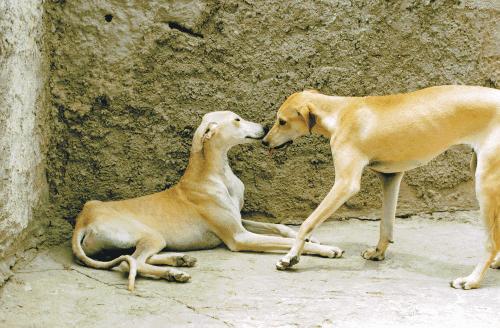
Sloughis, Bou Salem © Anne d'Ersu |
||
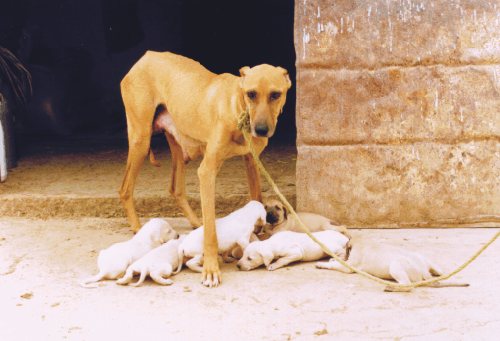
Cropped-eared mountain Sloughia with pups, Bou Salem © D. de Caprona |
|||
Sloughi pups,
Bou Salem © Dominique de Caprona
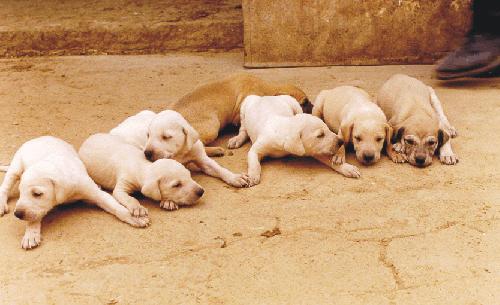 |
|||
Apart from the Sloughis that we saw in private homes, and the Kabyl shepherd dogs we saw herding sheep or goats, we saw no other breed of dog, except a Pointer-type dog at Salem Gharzallah's place, and two dogs which looked like crossbreds between Sloughi and Kabyl dog. The most common dog seems to be the Kabyl dog in various colors and sizes. It became quickly apparent that Sloughis are living under much tougher conditions, not so much because of a lack of care from their owners, but because they have to survive recent Parvovirus epidemics imported with dogs from elsewhere, and to cope with the endemic killers Babesiosis and Leishmaniasis. Veterinary care is in some cases out of reach; vaccines difficult to obtain. The Sloughi is not a common breed in Tunisia and its future remains uncertain. |
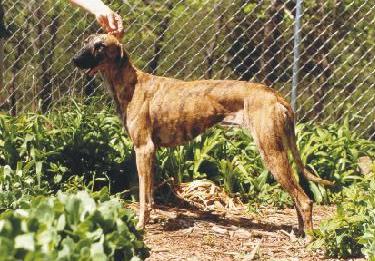
Ramla © D. de Caprona |
||
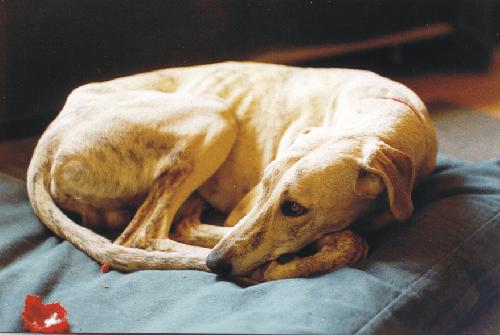
Tarfa © D. de Caprona |
|||
Rym
and friend near Geneva © D. de Caprona
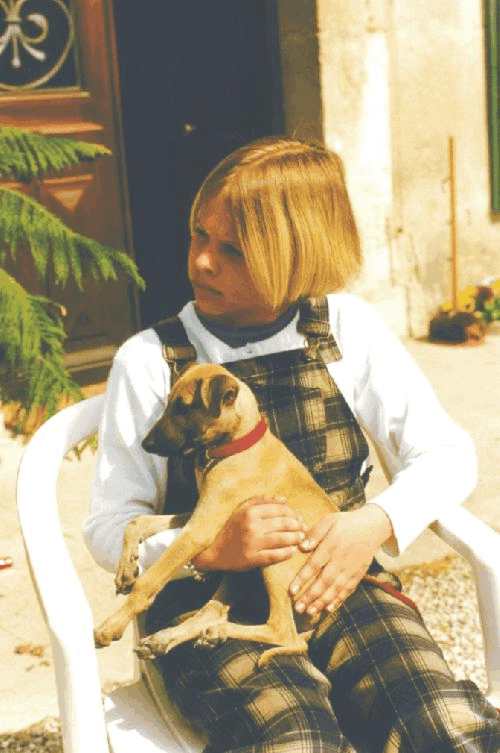 |
|||
At journey's end Ramla, the red brindle bitch and Tarfa, a nine-months old sand brindle dog joined Rym, and we headed for Tunis and the plane back to Geneva, Switzerland, first, then the USA. This trip turned out to be quite unique. The Swissair plane was first late, then changed at the last minute for a much smaller plane than the originally planned Airbus. The two crates for Ramla and Tarfa were too big for the cargo hold, I was told. We were asked to stay in Tunis until the next day. Back and forth and 3/4 of an hour later, I was driven to the pilot and together with the "cargo man" we discussed and discussed and discussed…..Finally one of the crates was taken apart and put back together again in the cargo bay itself. I crawled into the cargo hold with Tarfa in my arms, settled him carefully in his crate, and closed it. I then went very quickly to the back of the plane with Ramla and sat on a seat of the last row, with Ramla at my feet. My sister then came with Rym and sat next to me. Our neighbours were, thank God, a funny group of ladies who drank Champagne during the entire flight- I enjoyed a glass too. Ramla was perfectly still and enjoyed some of our Swissair meal. In Geneva, I carried Ramla down the ramp again and put her back in her crate to go through Customs. I crawled again into the cargo bay, carried Tarfa out, the crate was taken apart, put back together outside of the plane and Tarfa went back in. My sister and I were both relieved to arrive safely at my mother's place where a friend of the family had prepared a wonderful cheese fondue…. Ramla, Tarfa and Rym Cassandra entered the US on May 3rd, bringing with them some country-of-origin bloodlines of both Algerian and Tunisian ancestry to enrich the American Sloughi's gene pool. © 1999 Dominique de Caprona |
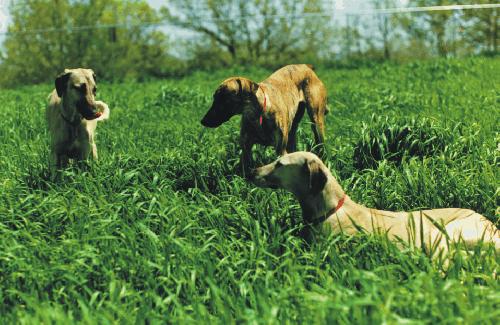
Hayifa, Ramla and Farissa © D. de Caprona |
||
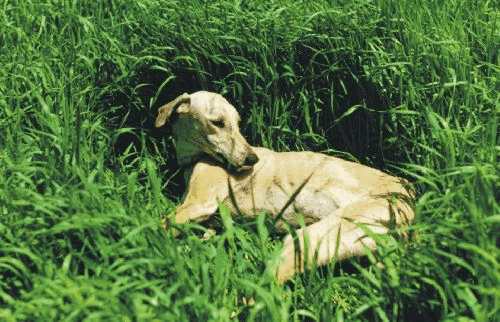
Tarfa and fresh grass © D. de Caprona |
|||
Rym at 8 months
© D. de Caprona
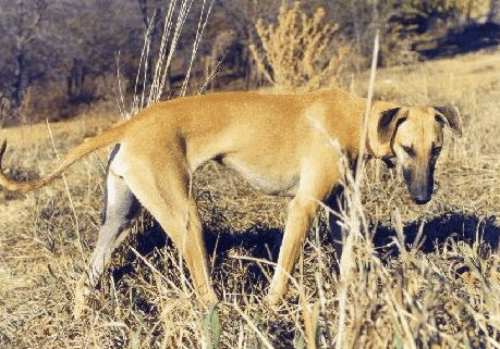 |
|||
|
Home - Champions
- Puppies - Racers/coursers
- Africans - Youngsters
- Veterans
|

Rym with mom and sister, Douz ©D. de Caprona |
||
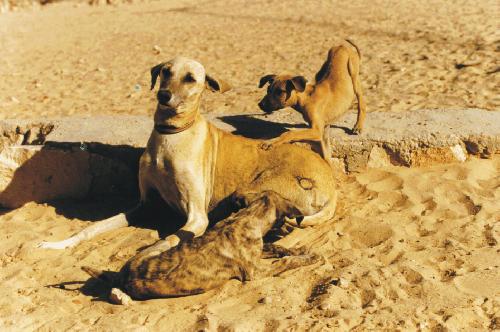
Rym with mom and sister, Douz ©D. de Caprona |
|||
|
|
|||